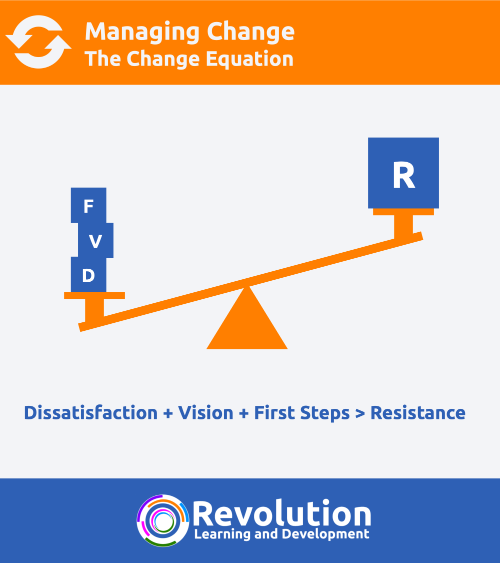Background
The change equation is a nice and simple way to demonstrate how to overcome resistance to change. Developed by Richard Beckhard and David Gleicher, the change equation shows us that certain forces added together need to be greater than resistance in order for change to succeed and stick.
According to a report called Mastering the Art of Change by Ken Blanchard, change strategies in an organisation have a failure rate of upwards of 70%. This means that businesses put a lot of time and effort into instigating change programmes in their organisation, but more fail to achieve the desired outcomes than those that do.
Why Does Change Fail?
Change fails due to poor planning and preparation or when changes are made when they are not necessarily needed. One of the main reasons for change failing is resistance to change. Those that are impacted by or who are involved in the change itself do not accept the change. This is because they have not fully bought into the idea of the change or they don’t see the benefit.
Resistance occurs when there is not enough work done up-front to engage those impacted by the change in the change programme. Often, change is forced on people for ‘operational requirements’ or ‘business need’. But, what are those requirements? What are those needs? If those involved don’t understand, they will never fully buy-in to the change and resist.
People also fear change. They fear the unknown. When we fear something, we don’t really want to go there. We need to help reduce the fear and turn this into positive excitement.
People fear change. They fear the unknown. When we fear something, we don't really want to go there. We need to help reduce the fear and turn this into positive excitement. Click To Tweet
The Change Equation
The change equation sets out beautifully what needs to happen in order for change to stick and resistance to be overcome. The change equation is:
D + V + F > R
Or Dissatisfaction plus Vision plus First Steps is greater than Resistance.

Dissatisfaction
The first part of the change equation is dissatisfaction. In order for change to be necessary, dissatisfaction needs to exist. This might be dissatisfaction with results, a process, timescales or customer satisfaction for example. This dissatisfaction becomes the catalyst for change and this gives us our ‘why’.
The why, or the background to the dissatisfaction should be shared with effective communication with all of those affected by the change. Without this understanding, those affected will not see the point of change and will instantly resist.
Vision
The next part of the change equation is vision. This is where we paint a picture of the future. We want and need those affected by the change to see what better looks like. We should create a compelling vision of what the future looks like after the change process has been completed and the changes embedded. Be sure to share with those affected what the benefits will be of the change – to them and the business. Explain what things will look like, feel like and work like after the process is completed.
First Steps
The final part of the change equation is first steps. This is where we help those affected understand the process they are about to go through. What’s the plan? What steps will we go through to get there and how long will it take. Be sure to help them to understand what support they will receive both throughout the process and after while the change is embedding. This might come in the form of communication, training or coaching for example.
Conclusion
Remember, resistance to change comes from fear of change and lack or clarity or understanding about why the change is needed. By using the change equation you can significantly reduce the amount of resistance you will get towards change.
Further Learning
If you would like to learn more about change management and the change equation you can attend a Change Management training course. Take a look at our Change Management Training Course for more details.




